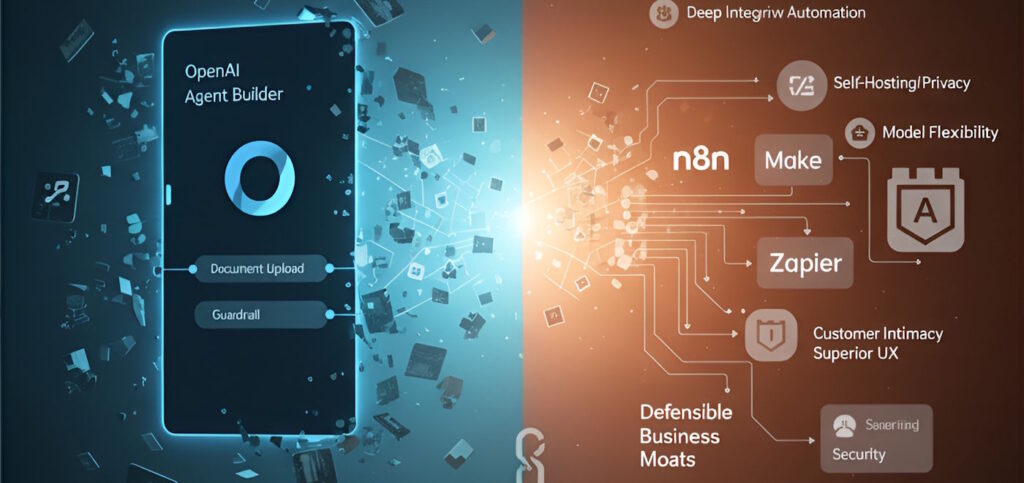This week, OpenAI released Agent Builder – and the AI community erupted with apocalyptic predictions. “This will kill tools like n8n, Make, and Zapier!” “OpenAI just signed the death warrant for thousands of startups!” I am not going to link to those articles, because I find them funny at best – and click-bait at worst.
My take? Not even close.
If anything, this release is good news. It increases competition, pushes innovation, and will only eliminate companies that were already living on borrowed time.
What Is Agent Builder?
But step by step, let’s first start with the basics. What is Agent Builder? It is a low-code automation platform – heavily centered around OpenAI’s own LLM-models. Basically, it allows you to build agents and simple automatons in a fast and simple way. You don’t need a software engineering background to use it, no need to write code. Is this special in itself in any way? No, not really – low-code platforms like n8n, make or zapier have been around for years and have included agent-functionality for a while. Of course, OpenAI releasing something itself will raise some alarm bells in those companies – and it should!
Will It Kill Low-Code Platforms?
While Agent Builder’s automation features are fairly basic and lack a lot of functionality that the more established platforms have included, I have noticed two things that OpenAI has added that I have missed in n8n when building agents (cannot judge the other two, have not found the time to play with either make or zapier).
1. Easy Document Upload for Agent Customization
Agent Builder makes it simple to upload documents directly into an agent’s memory. This feature has existed in LLM’s for ages – but somehow has not made it into n8n’s agents. To achieve something similar in n8n, you need to implement a full-blown RAG-system – doable if you know what you’re doing, but considerably more complex than a simple PDF upload.
2. Built-in Guardrails
Protecting agents from prompt injection attacks is challenging in practice. Agent Builder lets you drag and drop a guardrail node in front of your agent for instant protection. N8n doesn’t make this easy – the best resource I found on this requires significant technical expertise and definitely doesn’t fall into the “quick and easy” category. How good is the offered protection by OpenAI in practice? Too early to tell – but good to finally have something available to start from.
Why N8n and Others Will Survive
Here’s the good news for existing low-code automation companies: these features aren’t hard to replicate. More importantly, the existing solutions like n8n offer substantial advantages that OpenAI doesn’t:
Ecosystem Depth: n8n boasts a vastly larger integration ecosystem. OpenAI has some external vendors, but it pales in comparison to what others offer out of the box.
Workflow vs. Agents: Low-code doesn’t equal agents. Many real-world problems are better solved with workflow automation, not agentic AI. OpenAI doesn’t even pretend to compete here – their system is clearly agent-focused, while n8n is fundamentally a workflow automation system with agent capabilities.
Privacy and Self-Hosting: n8n is open-source and self-hostable. This enables privacy-critical use cases, especially in Europe where data protection regulations actually matter. Agent Builder is fully hosted and controlled by OpenAI – all your data and customer interactions flow through their servers. For many organizations, that’s a deal-breaker.
Model Flexibility: Agent Builder locks you into OpenAI’s models. N8n lets you experiment with different LLM providers to find the most cost-effective, high-performing solution for your specific use case.
Avoiding Vendor Lock-in: Do you really want your LLMs and low-code automation from the same vendor? Separating these concerns gives companies negotiation leverage when the inevitable price increases arrive.
The alarm bells should be ringing at these companies, though. Competition needs to drive them to close feature gaps – like adding easy agent customization and guardrail support to n8n. But they’re far from “deep trouble.”
Will It Kill Thousands of Startups?
Now for the dramatic claim: will Agent Builder kill thousands of startups by making it trivial for companies to build their own customer support chatbots and automations?
Here’s the reality: If your startup’s entire value proposition is a thin wrapper around an LLM with some basic workflow automation, you were never going to survive anyway.
Think about it this way as an example: the fleet automation agent/chatbot I recently described on this blog is a nice weekend-project. But it’s clearly not enough to build an entire company around. Building a chatbot demo is not a business model – it’s a technology-demonstrator or proof-of-concept at best. Real startups differentiate through:
- Deep customer understanding and needs analysis
- Solutions that truly satisfy customer requirements
- Exceptional user experience
- Robust security implementation
- Privacy compliance
- Strategic marketing and go-to-market execution
- Outstanding customer support
These are the moats that separate successful startups from side projects at tech giants like OpenAI.
Yes, some companies will fail because IT departments can now build internally what they once purchased. But those same IT departments would have discovered existing low-code platforms eventually anyways. Agent Builder hasn’t fundamentally changed this dynamic.
Summary
The bottom line: OpenAI’s Agent Builder is not an extinction event for low-code platforms or AI startups. It’s a wake-up call.
Established platforms like n8n, Make, and Zapier have clear competitive advantages: deeper integrations, mature workflow automation, self-hosting options, model flexibility, and freedom from vendor lock-in. Agent Builder’s initial advantages – simple document uploads and built-in guardrails – are features, not moats. They can and will be copied.
For startups, the message is simple: if a low-code tool can replicate your entire business, you never had a defensible business. Real competitive advantages come from customer intimacy, superior execution, exceptional UX, and comprehensive solutions – not from being first to wrap GPT in a simple interface.
Competition breeds innovation. Agent Builder’s release will push all players to improve their offerings, which ultimately benefits everyone. The weak will fall, but they were already wobbling. The strong will get stronger.
The sky isn’t falling. It’s just getting more competitive – exactly as it should be.


